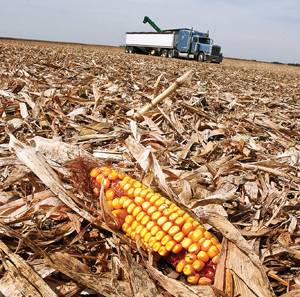Iowa farmers remain strong through weak economy

An ear of corn is missed during harvesting near Sherman, Ill., Friday, Sept. 19, 2008. A farming season that once appeared to be doomed by the weather has turned out pretty good for Midwest soybean and corn crops. (AP Photo/Seth Perlman)
October 18, 2008
In the face of a financial crisis, Iowa’s agricultural economy remains strong.
“From a historical prospective, we’re in pretty good shape,” said William Edwards, professor of agricultural economics and life sciences. “The last two years we’ve had record high net farm incomes in Iowa and that pretty much traces back to high grain prices.”
Edwards said Iowa farmers producing grain have benefited from high energy prices recently because of ethanol and the creation of ethanol plants across Iowa.
Although grain and corn producers have benefited, Edwards said livestock producers might be struggling.
“The last two years have been really good for grain producers, but not as good for livestock producers,” Edwards said. “Livestock producers are, obviously, on the other end of the negotiation because they are buying feed, so it’s been more expensive for them.”
Generally, Edwards said, family farmers produce both grain and livestock, so “it’s going out of one pocket, and coming into the other.” He said the livestock producers who are struggling right now are the large livestock-only operations that are not considered “family farms.”
Although many Iowa farmers struggled through the Great Depression, said Pamela Riney-Kehrberg, professor of history and director of agricultural history and rural studies, farmers are better off now if a similar economic crisis would occur.
“Agriculture in general, if we are headed for a time of relatively serious economic downturn, we are heading into that with support structures in place that didn’t exist in the 1930s,” Riney-Kehrberg said. “In the 1930s they had to basically create all that from scratch — there were no farm supports, there were no federally-funded flood insurance measures.”
Edwards said one of the major changes since the depression for Iowa farmers is that farmers’ wives and often the farmers themselves have careers outside of farming.
At this point, Riney-Kehrberg said, agriculture is strong, and definitely not in the same shape Iowa farmers were in during the Great Depression.
“One of the main ways that it is different, is that agricultural prices haven’t crashed at this point,” Riney-Kehrberg said. “It’s not anything like it was in between 1929 and 1933, when the price of a bushel of wheat, for example, fell from one dollar to 25 cents. Farmers could not pay the cost of production at all. We’re certainly not in a situation like that right now.”
Both Riney-Kehrberg and Edwards said input costs have increased dramatically since the Great Depression, and high input costs could hold farmers back.
“Agriculture has changed enormously since the 1930s,” Riney-Kehrberg said. “Farmers are much more dependent on credit, and they are much more reliant on very expensive technology, so getting by on a shoestring is much harder than it was in the 1930s.”
She said in the ‘30s, most farmers produced most of what they consumed, and this practice changed with the expansion of farm operations after World War II.
“The downside lately has been that the farmers input cost has been going up very rapidly,” Edwards said. “The cost of fertilizer has doubled in the last couple of years, seed, also.”
Along with higher input costs, farmers may see a decrease in the price of food exports, since foreign markets have been falling as well.
“Farmers rely on selling a certain amount of our product overseas and if they can’t afford to buy our product overseas, then we have a problem,” Riney-Kehrberg said. “We sell a lot of meat overseas to the Japanese, and right now the Japanese markets are doing OK. So you really have to look at it case-by-case.”
Edwards said export prices could fall, but didn’t think it would have a drastic effect on Iowa farmers.
“The food purchases tend to be very inelastic — in other words, people will continue to buy food even if they stop buying cars and other things,” Edwards said. “So I don’t think it will be too affected.”
Edwards said a weak dollar globally has actually helped farmers because it makes it easier for foreign countries to buy agricultural products from the U.S.
One thing that would really threaten farmers now, Edwards said, is if energy prices and crop prices both fall.
“The worry is that crop prices will drop and the prices for the things they have to buy will stay high,” Edwards said. “If that happens we’ll have some serious problems.”
Edwards said farming is “cyclical” and most farmers will save extra money from good years to help out in harder years.
One thing farmers today can learn from history, Riney-Kehrberg said, is to be conservative with their money during harsh economic times.
“The farmers who survived the downturn during the ‘30s were those that were conservative with their money,” Riney-Kehrberg said. “But I think that most farmers already know that being conservative in a downturn is what it takes to survive.”






